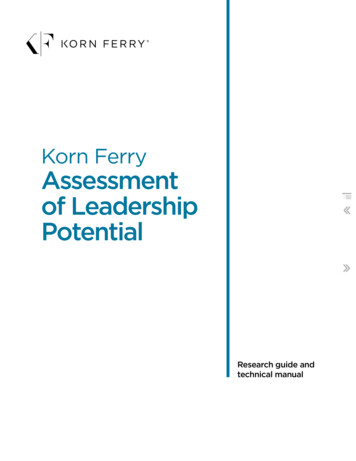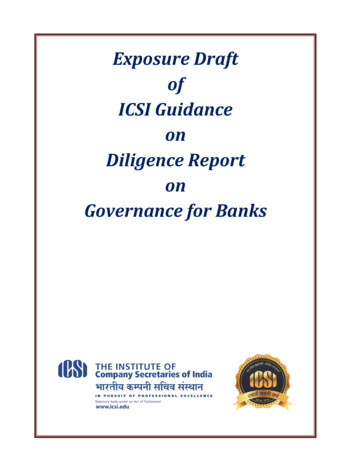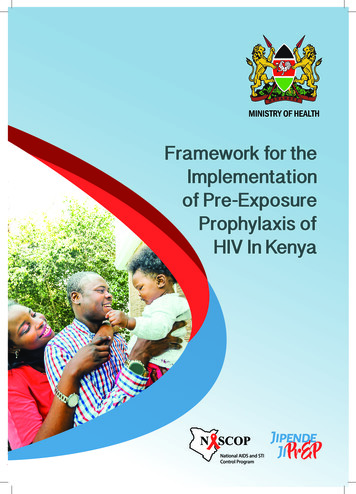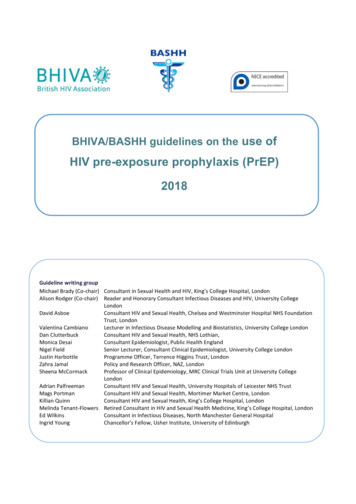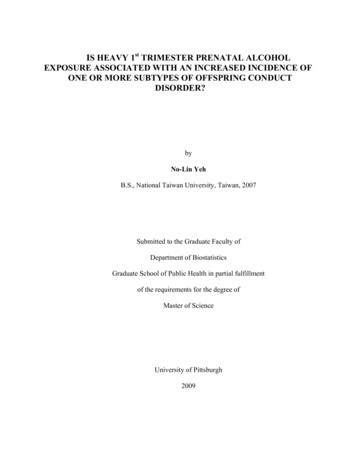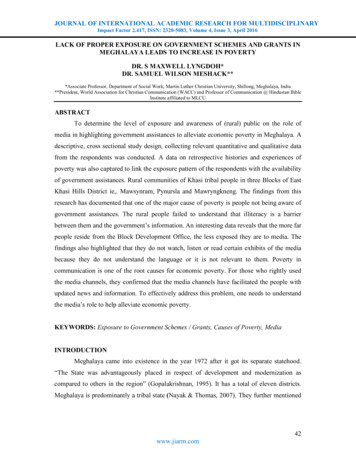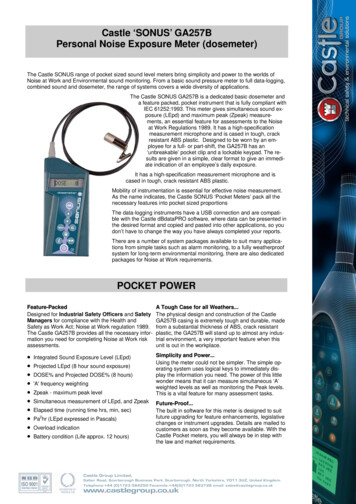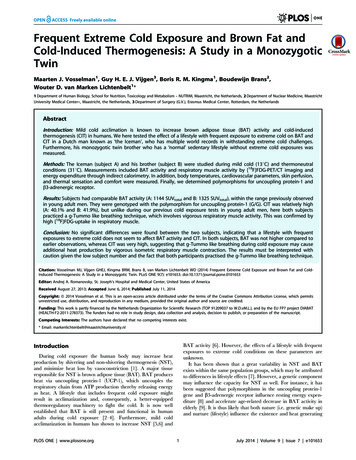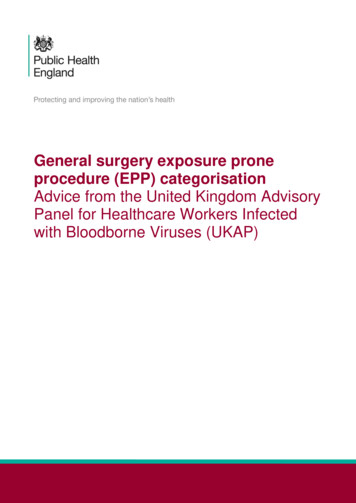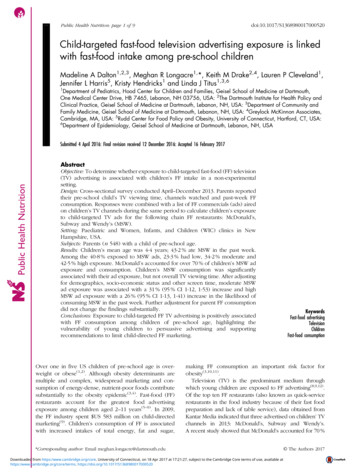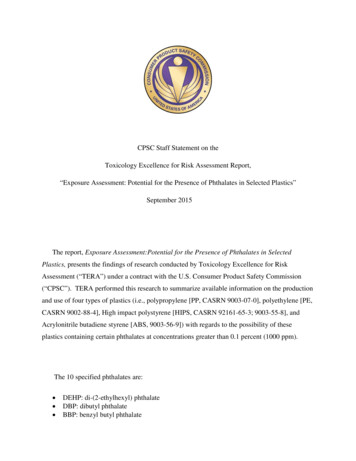
Transcription
CPSC Staff Statement on theToxicology Excellence for Risk Assessment Report,“Exposure Assessment: Potential for the Presence of Phthalates in Selected Plastics”September 2015The report, Exposure Assessment:Potential for the Presence of Phthalates in SelectedPlastics, presents the findings of research conducted by Toxicology Excellence for RiskAssessment (“TERA”) under a contract with the U.S. Consumer Product Safety Commission(“CPSC”). TERA performed this research to summarize available information on the productionand use of four types of plastics (i.e., polypropylene [PP, CASRN 9003-07-0], polyethylene [PE,CASRN 9002-88-4], High impact polystyrene [HIPS, CASRN 92161-65-3; 9003-55-8], andAcrylonitrile butadiene styrene [ABS, 9003-56-9]) with regards to the possibility of theseplastics containing certain phthalates at concentrations greater than 0.1 percent (1000 ppm).The 10 specified phthalates are: DEHP: di-(2-ethylhexyl) phthalateDBP: dibutyl phthalateBBP: benzyl butyl phthalate
DINP: diisononyl phthalateDIDP: diisodecyl phthalateDnOP: di-n-octyl phthalateDIOP: diisooctyl phthalateDIBP: diisobutyl phthalateDPENP: di-n-pentyl phthalateDHEXP: di-n-hexyl phthalateThis research was completed in support of CPSC’s work on third party testing burdenreduction consistent with assuring compliance. CPSC staff will consider this information inevaluating whether staff could make a recommendation for a Commission determination that theplastics listed do not contain any of the 10 specified phthalates in concentrations above 0.1percent, and thus, may not require third party testing to assure compliance with section 108 ofthe Consumer Product Safety Improvement Act of 2008.This report will be posted on CPSC’s website to keep stakeholders informed of the progressof technical research related to the agency’s regulatory activities .
Exposure Assessment:Potential for thePresence of Phthalatesin Selected PlasticsTask Order 12Contract NumberCPSC-D-12-0001October 1, 2015Final ReportPrepared by:Toxicology Excellence for Risk Assessment (TERA)University of CincinnatiContact:Patricia McGinnis mcginnis@tera.orgJeanelle Martinez martinez@tera.orgBernard Gadagbui gadagbui@tera.orgAlison Willis willis@tera.orgDouglas Lee lee@tera.orgAnn Parker parker@tera.orgMelissa Vincent vincent@tera.orgExternal Review: Stephen Thiel thiels@uc.edu
Table of Contents1 Introduction . 7Table 1-1. Specified Phthalates. 72 Literature Review Strategy . 92.1 Tier 1, Universe of Literature . 102.2 Tier 2, Reviewing Authoritative Secondary Sources (Websites). 122.3 Tier 3, Reviewing Authoritative Secondary Sources (Library) . 142.4 Tier 4, Literature Searching . 152.5 Tier 5, Gap Searching. 173 Polypropylene CASRN: 9003-07-0 . 183.1 Raw Materials Used in Production of Polypropylene (PP) . 183.2 Raw Materials Used in making Virgin PP Resin . 183.3 Manufacturing Processes used Worldwide to Produce PP. 183.3.1Processing . 213.4 Applications for Polypropylene in Consumer Products . 213.4.1Toys and Child Care Articles . 213.4.2Other Consumer Products . 223.5 Potential Use of Recycled Materials Containing Phthalate in Production ofPolypropylene . 233.6 Potential Phthalate Contamination . 243.7 References . 254Polyethylene CASRN: 9002-88-4. 284.1 Raw Materials Used in Production of Polyethylene (PE) . 284.2 Manufacturing Processes used Worldwide to Produce PE . 294.2.1Additives . 304.2.2Processing . 314.3 Applications for Polyethylene (CASRN 9002-88-4) in Consumer Products . 314.3.1Toys and Child Care Articles . 314.3.2Other Consumer Products . 324.4 Recycling of Polyethylene . 334.5 Migration and Contamination . 344.6 References . 345High Impact Polystyrene (HIPS) CASRN: 9003-55-8 . 385.1 Raw Materials Used in Production of High impact polystyrene (HIPS) . 385.2 Manufacturing Processes used Worldwide to Produce HIPS . 385.2.1Processing . 405.3 Applications for High impact polystyrene (HIPS) (CASRN 9003-55-8) in ConsumerProducts. 40i
5.3.1Toys and Child Care Articles . 405.3.2Other Consumer Products . 405.4 Recycling of HIPS . 415.5 Migration and Contamination . 425.6 References . 426Acrylonitrile butadiene styrene CASRN: 9003-56-9 . 456.1 Raw Materials Used in Production of ABS . 456.2 Manufacturing Processes used Worldwide to Produce ABS . 466.2.1Emulsion Polymerization Process. 476.2.2Preparation of PB Rubber Latex . 476.2.3Preparation of ABS Latex . 476.2.4Preparation of Mass Polymerization ABS . 486.2.5Processing . 486.3 Applications for ABS in Consumer Products . 486.3.1Toys and Child Care Articles . 486.3.1Other Consumer Products . 496.4 Recycling of ABS. 506.5 Migration and Contamination . 516.6 References . 517Summary . 558Appendix A . 609Appendix B . 6410 Appendix C . 6411 Appendix D . 9611.1 Recycling of Plastics . 9611.2 Mechanical recycling . 9611.3 Thermal Reprocessing . 9711.4 Chemical Recycling . 9811.5 Energy Recovery . 9811.6 Volumes of Recycled Plastics . 9811.7 Problems associated with the use of recycled plastics. . 9911.8 References . 100ii
Table 1-1. Specified Phthalates. 7Table 2-1. Evaluation of the Universe of Literature (Tier 1) . 11Table 2-2. Tier 2 Secondary Literature Search Terms . 13Table 2-3. Information for Six Factors Gathered from Nine Relevant Websites in Tier 2 . 13Table 2-4. Tier 3 resources reviewed from UC Book Catalog . 14Table 2-5. Search Table using Polyethylene as an example . 15Table 7-1. Overview of plastics found in certain materials . 58Table 7-2. Overview of phthalates found in plastics . 59Figure 1. Research Approach for Five Factors for Four Specified Plastics. 10Figure 2. Mechanical recycling steps as described in Al-Salem et al., 2009. . 97iii
AbbreviationsABFAABSACGIHAEGLATHATPATSDRBBPBHT mideAcrylonitrile butadiene styreneAmerican Conference of Governmental Industrial HygienistsAcute Exposure Guideline LevelsAluminum trihydrateα-tocopherolAgency for Toxic Substances and Disease RegistryBenzyl butyl phthalate2,6-di-t-butyl-4-methylphenoldegree CelsiusCalcium chlorideChemical Abstracts Service Registry NumberCompact discChemical Data Reporting-Chemical Data Access ToolCanadian Environmental Protection ActU.S. Consumer Product Safety CommissionCarcinogen Risk Assessment Verification EndeavorChromium trioxideCathode ray tubes monitorDibutyl phthalateDicyclohexyl phthalateDecabromodiphenyl oxideDi(2-ethylhexyl) adipateDi-(2-ethylhexyl) phthalateDihexyl phthalateDiisobutyl phthalateDiisononyl phthalateDiisooctyl phthalateDi-n-octyl phthalateDi-n-pentyl phthalateDi-n-octyl adipateDioctyl phthalateDibutyl phthalateDipentyl phthalateDi-n-pentyl phthalateDigital video discEuropean Chemicals AgencyAlkylamine acid phosphateIron (II) sulfateGrams per cubic centimeterGrams per centimeterHigh density polyethyleneHigh density polypropyleneiv
mpptproCATPSPVCHigh impact polystyreneHousehold Products DatabaseHazardous Substances Data BankInternational Agency for Research on CancerIntergovernmental Forum on Chemical SafetyInternational Programme on Chemical SafetyIntegrated Risk Information SystemInternational Toxicity Estimates for RiskKilometerPotassium persulfateLow density polyethyleneLinear low density polyethyleneMedium density polyethyleneMilligrammilligram(s) per kilogram(s)MegapascalMetallocene polyethyleneSodium persulfateCross-linked nitrile rubberNational Industrial Chemicals Notification and Assessment SchemeNational Institutes of HealthNational Institute for Oc
01.10.2015 · 11.2 Mechanical recycling . 96 11.3 Thermal Reprocessing. 97 11.4 Chemical Recycling . 98 11.5 Energy Recovery . 98 11.6 Volumes of Recycled Plastics . 98 11.7 Problems associated with the use of recycled plastics. . 99 11.8 References . 100 . iii Table 1-1. Specified Phthalates. 7 Table 2-1. Evaluation of the Universe of Literature (Tier 1). 11 Table 2-2 .
